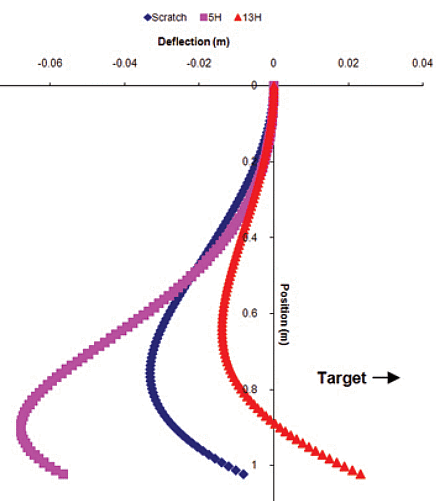I have wrongly accused John Erickson of being a charlatan because he claimed that he can “hold shaft flex” throughout the downswing into the early followthrough, but I have never seen him accomplish that goal in a full golf swing action.
Here are capture images from his full driver golf swing action where he tried to swing like Hogan.
= First set of capture images.
You can see that he is “holding shaft flex” at P5.2 (image 1) and at P5.5 (image 2) but his peripheral clubshaft is bent forward at P6.2 which means that he cannot be “holding shaft flex” during his later downswing. The clubshaft has also bypassed his lead arm between P7 (image 4) and P7.4 (image 5) which means that he cannot be “holding shaft flex” in his early followthrough.
Until now, I have only seen him “hold shaft flex” in his later downswing/early followthrough when he uses an artificially shortened backswing action involving minimal clubhead lag at the shortened P4 position.
However, his latest video - https://youtu.be/f2tb4ltFQEI - shows him seemingly “holding shaft flex” during his later downswing/early followthrough when performing a full golf swing action.
Here are capture images from the video.
= Second set of capture images.
Image 1 (nearing P6) shows that his peripheral clubshaft is bent backwards and he is very likely “holding shaft flex” at the this time point in the mid-downswing. I have not presented any capture images of his P4 => P5.2 time period, but if you look at his video you will see that he has minimal backwards bending of the clubshaft during his early downswing. That would suggest that JE is not accelerating his lead hand between P4 => P5.2 (like most pro golfers who are TGM swingers and as was also seen in that first set of capture images ) and that he is only earnestly starting to accelerate his lead arm motion starting between P5.5 => P6.
Note that his peripheral clubshaft is still bent backwards at P6.2 (image 2) which is very different to his P6.2 scenario in that first set of capture images and I can easily accept that he is “holding shaft flex” at his P6.2 position. I can even accept that he is still “holding shaft flex” at P6.5 (image 3) and at P6.9 (image 4) even though there may be minimal forwards bend of his peripheral clubshaft, which is likely due to the club releasing phenomenon (release of PA#2) which is happening in his later downswing. The amount of fowards bend of the peripheral clubshaft is very small between P6.5 => P7 and I can readily accept his claim that he is using a “holding shaft flex” technique at the level of the club handle in this particular full golf swing action.
Image 5 is at P7.3. Note that the clubshaft has not bypassed his lead arm and note that the peripheral clubshaft is bent backwards. Both of those facts are compatible with JE’s claim that he is “holding shaft flex” during his early followthrough. JE also claims that he is accelerating his lead hand throughout his later downswing and through impact when performing his “holding shaft flex” technique, but that fact cannot be confirmed by viewing these capture images. JE should really be willing to have a GEARS evaluation because it may indeed show that his claims of not decelerating his lead hand motion between P5.5 => P7 (as seen in most pro golfers who use a TGM swinging technique) is true. Even if a GEARS evaluation does not show that he is actually accelerating his lead hand motion through impact, it would be amazing to learn that he can avoid lead hand deceleration happening between P5.5 => P7. JE states that there would be travel expenses involved in having a free GEARS evaluation performed by Eric Barzewski in Pennsylvania, but he could crowd-fund his travel expenses. I would be willing to donate $20 to any crown-funding method of paying for his travel expenses, and I am sure that many other people would also contribute enough to totally fund all of his travel expenses.
I would also like to see JE being scientifically evaluated using an instrumented grip handle combined with pressure sensors being present at PP#1 (located over his lead thumb’s base) and on the aft side of the club handle at PP#3. That could possibly confirm JE’s assertion that he is applying a positive push-pressure with his trail hand against the aft side of the club handle and at PP#1 during his later downswing and early followthrough. That “fact” would really turn the golf instructional world upside-down and create a furor because many golf instructors claim that it does not ever happen in a professional quality type of full golf swing action.
Jeff.





